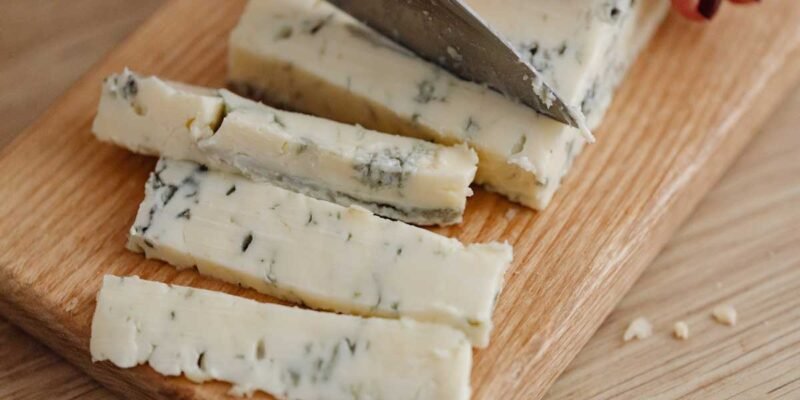Walk into any upscale grocery store today, and you’ll notice something interesting happening in the cheese section. Alongside familiar favorites like brie and cheddar, there’s a growing selection of fusion cheeses that didn’t exist a decade ago. One standout that’s been gaining serious traction is masgonzola – and for good reason.
If you’ve ever wanted to try blue cheese but found traditional gorgonzola too intense, masgonzola might just be your gateway. This Italian innovation takes the creamy sweetness of mascarpone and blends it with the tangy complexity of gorgonzola dolce, creating something that’s both familiar and surprisingly new.
What is Masgonzola? Understanding This Unique Cheese Blend
Think of masgonzola as the diplomatic solution to the blue cheese debate. It starts with mascarpone – that impossibly smooth Italian cream cheese you might know from tiramisu – and combines it with gorgonzola dolce, the milder cousin of regular gorgonzola.
The magic happens in how these two play together. The mascarpone doesn’t just mask the blue cheese flavor; it actually enhances it while taking away that sharp bite that makes some people wrinkle their noses. What you get is all the interesting complexity of blue cheese with a texture that’s almost buttery.
It’s become a favorite among cheese shop owners because it converts the “I don’t like blue cheese” crowd faster than anything else they stock. Once people try it, they usually end up taking some home.
The Italian Heritage Behind Masgonzola
You can’t talk about masgonzola without understanding where its parents came from. Mascarpone has been around since the 1600s in Lombardy, where it started as a way to use up excess cream. Italian cooks discovered that adding a touch of acid to heated cream created this incredible, almost dessert-like cheese.
Gorgonzola’s story goes back even further – we’re talking 9th century near Milan. Legend has it that a young cheesemaker got distracted by romance and left his cheese curds out overnight. The next morning, he found blue-green mold had taken hold, but instead of throwing it away, he aged it anyway. The result became one of Italy’s most famous exports.
Fast forward to today, and some creative minds decided these two classics could work together. It’s not about replacing tradition – it’s about building on it. The best masgonzola producers still use the same careful techniques their ancestors perfected, just with a modern twist.
Taste Profile and Texture: What Makes Masgonzola Special
Here’s where masgonzola really shines. Take your first bite, and you’ll notice the creamy mascarpone hits first – smooth, slightly sweet, almost like a savory whipped cream. Then comes the gorgonzola, but not in an aggressive way. It builds gradually, adding depth and that distinctive blue cheese tang without ever becoming overwhelming.
The texture is what really sets it apart from other blue cheeses. Instead of the crumbly, sometimes grainy feel of aged gorgonzola, masgonzola spreads like butter at room temperature. It melts beautifully too, which makes it incredibly versatile in cooking.
Visually, it’s quite striking – pale cream with those characteristic blue-green veins running through it like marble. The aroma is inviting rather than intimidating, with just enough funk to let you know there’s something interesting going on without clearing the room.
How Masgonzola is Made: From Traditional Cheeses to Fusion Creation
The production of masgonzola begins with high-quality mascarpone and gorgonzola dolce, both brought to optimal temperature for blending. Commercial producers maintain strict quality controls to ensure consistency in texture and flavor across batches.
Traditional artisan methods involve careful hand-mixing to preserve the integrity of both cheese components while achieving proper integration. The timing of this process proves critical, as the cheeses must reach the perfect consistency for blending without compromising their individual characteristics.
Home enthusiasts can create their own version by combining room-temperature mascarpone with softened gorgonzola dolce, adjusting ratios according to personal taste preferences. This DIY approach allows for customization while providing insight into the careful balance required for optimal results.
Culinary Applications: Cooking with Masgonzola
The versatility of masgonzola shines through its numerous culinary applications. Its excellent melting properties make it ideal for cream-based pasta sauces, where it adds richness without the heaviness that can accompany traditional cream sauces.
Cold applications showcase masgonzola’s spreadable nature perfectly. It serves as an elegant base for crostini, elevating simple bread into sophisticated appetizers when paired with complementary ingredients like fresh herbs or seasonal fruits.
The cheese’s balanced flavor profile allows it to enhance dishes without dominating other ingredients. This quality makes it particularly valuable in recipes where subtle complexity is desired rather than bold, assertive flavors.
5 Delicious Masgonzola Recipes to Try at Home
Masgonzola-Stuffed Chicken Breast with Fresh Herbs
Butterfly chicken breasts and create a pocket for the filling. Combine masgonzola with chopped thyme and basil, then stuff the mixture into the chicken. Secure with toothpicks and sear before finishing in the oven until cooked through.
Gourmet Grilled Cheese with Crisp Apple Slices
Layer masgonzola and thinly sliced Granny Smith apples between slices of artisanal bread. The cheese’s creaminess pairs beautifully with the apple’s tartness, creating a sophisticated twist on the classic comfort food.
Creamy Masgonzola Pasta with Garlic and White Wine
Melt masgonzola with minced garlic and a splash of white wine to create an instant gourmet sauce. Toss with hot pasta and finish with fresh cracked black pepper and chopped parsley.
Roasted Vegetable Medley with Balsamic Glaze
Roast seasonal vegetables until caramelized, then top with crumbled masgonzola while still warm. Drizzle with balsamic reduction for a perfect balance of sweet, savory, and tangy flavors.
Elegant Cheese Board Presentation
Feature masgonzola as the centerpiece of a sophisticated cheese board, surrounded by fresh figs, toasted walnuts, and artisanal crackers for an impressive entertaining option.
Perfect Pairings: What Goes Best with Masgonzola
Fruit pairings bring out masgonzola’s subtle sweetness while providing textural contrast. Fresh figs offer natural sweetness that complements the cheese’s complexity, while crisp pears add refreshing balance to its richness.
Wine selections should consider masgonzola’s dual nature. Sweet wines like port enhance its creamy characteristics, while crisp whites such as sauvignon blanc provide acidic contrast that cleanses the palate between bites.
Nuts add textural interest and earthy flavors that harmonize with masgonzola’s complexity. Toasted walnuts and sliced almonds both work exceptionally well, providing crunch that contrasts with the cheese’s smooth texture.
Health Benefits and Nutritional Value of Masgonzola
Masgonzola provides significant protein content, supporting muscle health and providing sustained energy. The cheese also contains essential calcium for bone strength and dental health, making it a nutritious addition to balanced meals.
Vitamins A and B12 present in masgonzola contribute to overall wellness, supporting vision health and energy metabolism respectively. These nutrients make the cheese more than just a flavorful indulgence.
However, like most rich cheeses, masgonzola should be enjoyed in moderation due to its fat and sodium content. When incorporated thoughtfully into meals alongside fresh vegetables and whole grains, it can be part of a healthy, balanced diet.
Storage Tips and Where to Buy Masgonzola
Proper storage ensures masgonzola maintains its optimal texture and flavor. Wrap the cheese in parchment paper before placing it in an airtight container, allowing it to breathe while preventing moisture loss.
Refrigerate masgonzola in the coldest part of the refrigerator, typically the main compartment rather than the door. Use within one to two weeks of opening for the best quality and flavor experience.
Quality masgonzola can be found at specialty cheese shops, gourmet grocery stores, and Italian delicatessens. Online retailers also offer artisanal versions, though it’s important to verify proper shipping methods to maintain the cheese’s integrity during transport.
















